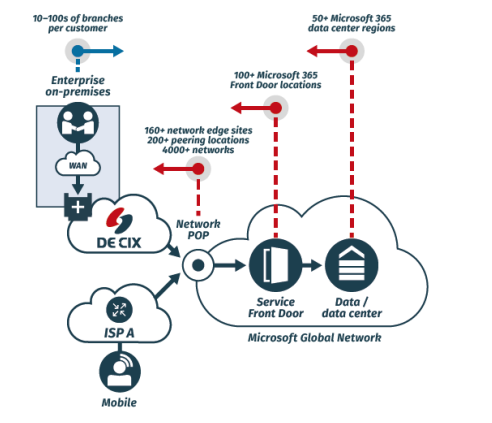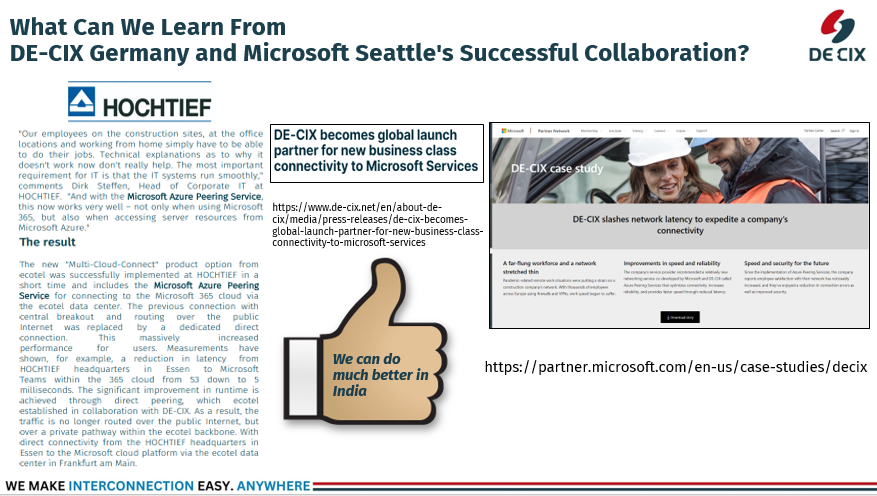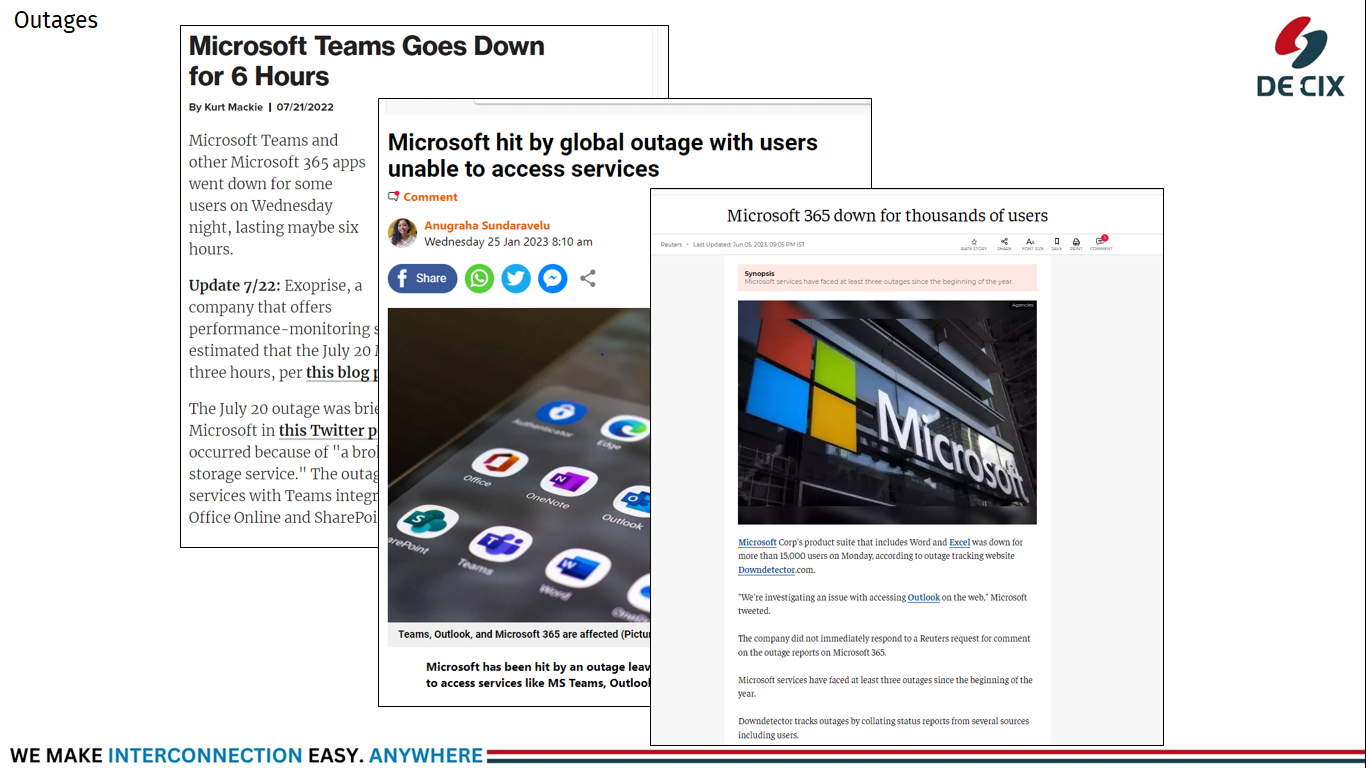Blogs
Microsoft Azure Peering Service: An Overview
As an internet service provider or enterprise, you’re constantly seeking ways to optimise your network performance and deliver superior connectivity to your customers. Microsoft Azure Peering Service, a cutting-edge solution designed to enhance your direct connectivity to Microsoft’s global network. This service offers you a more reliable and optimised network experience for your users accessing Microsoft’s cloud services. In this article, you’ll discover how Azure Peering Service works and explore its benefits for your organisation. Additionally, you’ll learn about DE-CIX India’s role in this ecosystem, providing you with valuable insights to make informed decisions about your network infrastructure and cloud connectivity strategies.
What is Microsoft Azure Peering Service?
Optimizing Cloud Connectivity
Microsoft Azure Peering Service is a networking solution that enhances connectivity to Microsoft’s cloud services, including Microsoft 365, Dynamics 365, and Azure. This service optimises public internet routing, providing customers with reliable and high-performing connectivity to the Microsoft network. By partnering with internet service providers (ISPs), internet exchange partners (IXPs), and software-defined cloud interconnect (SDCI) providers, Microsoft ensures optimal routing from the customer to its cloud services.
Key Benefits and Features
The Microsoft Azure Peering Service offers several advantages for enterprises and service providers:
- Best public routing over the internet for optimal performance and reliability
- Traffic insights, including latency reporting and prefix monitoring
- Optimum network hops from the Microsoft cloud
- Route analytics and statistics, including BGP route anomalies detection
According to Microsoft, the service uses redundancy at both local and geo-levels to ensure robust and reliable connectivity.
How Azure Peering Service Works?

Direct and Optimised Connectivity
The Azure Peering Service provides a direct, private connection between your network and Microsoft’s cloud services, bypassing the public internet. This dedicated pathway offers highly reliable and optimised internet connectivity to Microsoft’s SaaS services like Microsoft 365 and Dynamics 365. By leveraging this service, you can experience improved network performance, enhanced security, and simplified network management.
Collaboration with Internet Exchange Providers
Microsoft collaborates with leading internet exchange operators like DE-CIX to expand the reach of Azure Peering Service. For instance, DE-CIX now offers this service through its Mumbai and Chennai platforms, enabling SMEs, enterprises, telcos, and ISPs to benefit from enterprise-class interconnection services. This collaboration ensures that you can access Microsoft’s cloud services with low latency and high bandwidth, closer to your location.
Flexible Connectivity Options
To utilise the Azure Peering Service, you can connect your on-premises network to a Microsoft edge location through a supported internet service provider or exchange provider. The service supports both Layer 2 and Layer 3 connections, offering flexibility in how you establish your connection. Once connected, you can easily provision and manage your Azure Peering Service connections through the Azure portal or API, streamlining your cloud connectivity management process.
Benefits of Azure Peering for Providers
Enhanced Performance and Reliability
Azure Peering Service offers providers a unique opportunity to deliver superior connectivity to Microsoft cloud services.
By optimising routing on the Microsoft network, the service ensures high availability and predictable performance. This optimisation allows providers to offer their customers a more reliable and efficient connection to critical services like Microsoft 365 and Dynamics 365.
Improved Customer Satisfaction
Providers can significantly enhance their value proposition by offering Azure Peering Service. The service’s ability to provide consistent, predictable performance with a service level agreement (SLA) means providers can guarantee a superior user experience. This leads to increased customer satisfaction and potentially higher retention rates, as businesses rely more heavily on cloud-based applications.
Advanced Monitoring and Insights
Azure Peering Service equips providers with powerful tools for network management. The service offers traffic insights such as latency reporting and prefix monitoring, enabling providers to proactively address issues and optimise their networks. Additionally, route analytics and statistics, including detection of BGP route anomalies, allow providers to maintain optimal routing and quickly resolve any connectivity problems.
Competitive Advantage
By partnering with Microsoft for Azure Peering Service, providers can differentiate themselves in a crowded market. The ability to offer optimised public connectivity and local internet breakouts positions providers as premium partners for businesses heavily reliant on Microsoft cloud services. This competitive edge can lead to increased market share and revenue growth opportunities.
USED CASES:
HOCHTIEF AND Microsoft Azure Peering Service (MAPS)

HOCHTIEF, the world’s 5th largest construction company, faced challenges with latency and connectivity between their infrastructure and Microsoft’s servers. By utilising Microsoft Azure Peering Service (MAPS) through DE-CIX, they experienced a remarkable transformation. The number of hops between their infrastructure and Microsoft’s servers drastically decreased, leading to a significant reduction in latency by 90% and consistently leading to a 50% reduction in trouble tickets. Specifically, HOCHTIEF’s Multi-Cloud-Connect Service by ecotel , powered by MAPS, brought down the connection time to Microsoft Teams from their headquarters from 53 milliseconds to just 5 milliseconds. This drastic improvement revolutionised their communication and collaboration capabilities, enabling faster and more efficient employee interactions, and ultimately boosting productivity and operational efficiency.
Conclusion
As a provider, leveraging the Microsoft Azure Peering Service through DE-CIX India offers significant advantages for your enterprise customers. By optimising routing and reducing latency, you can deliver an enhanced user experience for Microsoft 365 and other Azure-based applications. The service’s built-in redundancy and direct connectivity ensure reliable performance, even during network disruptions. As cloud adoption continues to accelerate, offering Azure Peering Service positions you as a forward-thinking partner equipped to meet evolving business needs. By embracing this solution, you’ll strengthen your competitive edge and provide added value to your customers. Consider exploring Azure Peering Service through DE-CIX India to elevate your service offerings and drive customer satisfaction

News piece of DE-CIX Microsoft Azure Peering Service services impact on HOITCHEF
Subscribe to Newsletter
